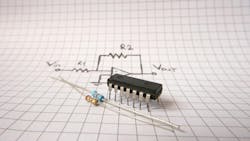Basic Op Amp Circuits with Quizplanation (Download)
Operational amplifiers are a basic component that are discussed in most analog electronics text books. Their origins are primarily military and Walt Jung provides a very thoroughly researched history of op amps in the classic "Chapter H" of his excellent and comprehensive 2005 book Op Amp Applications Handbook.
Back in the early days, op amps were comprised of vacuum tubes, including the venerable K2W vacuum tube op amp, which we covered extensively here on Electronic Design, which formed the basis of analog computers in the 1950s through to the early 70s. The K2W's success came from its low cost, adequate performance, and ease of use — this was primarily due to the fantastic application notes, produced by George Philbrick Researches, which illustrated the various combinations of "ops" (operations) that the K2W and its siblings could be configured to perform analog computation.
